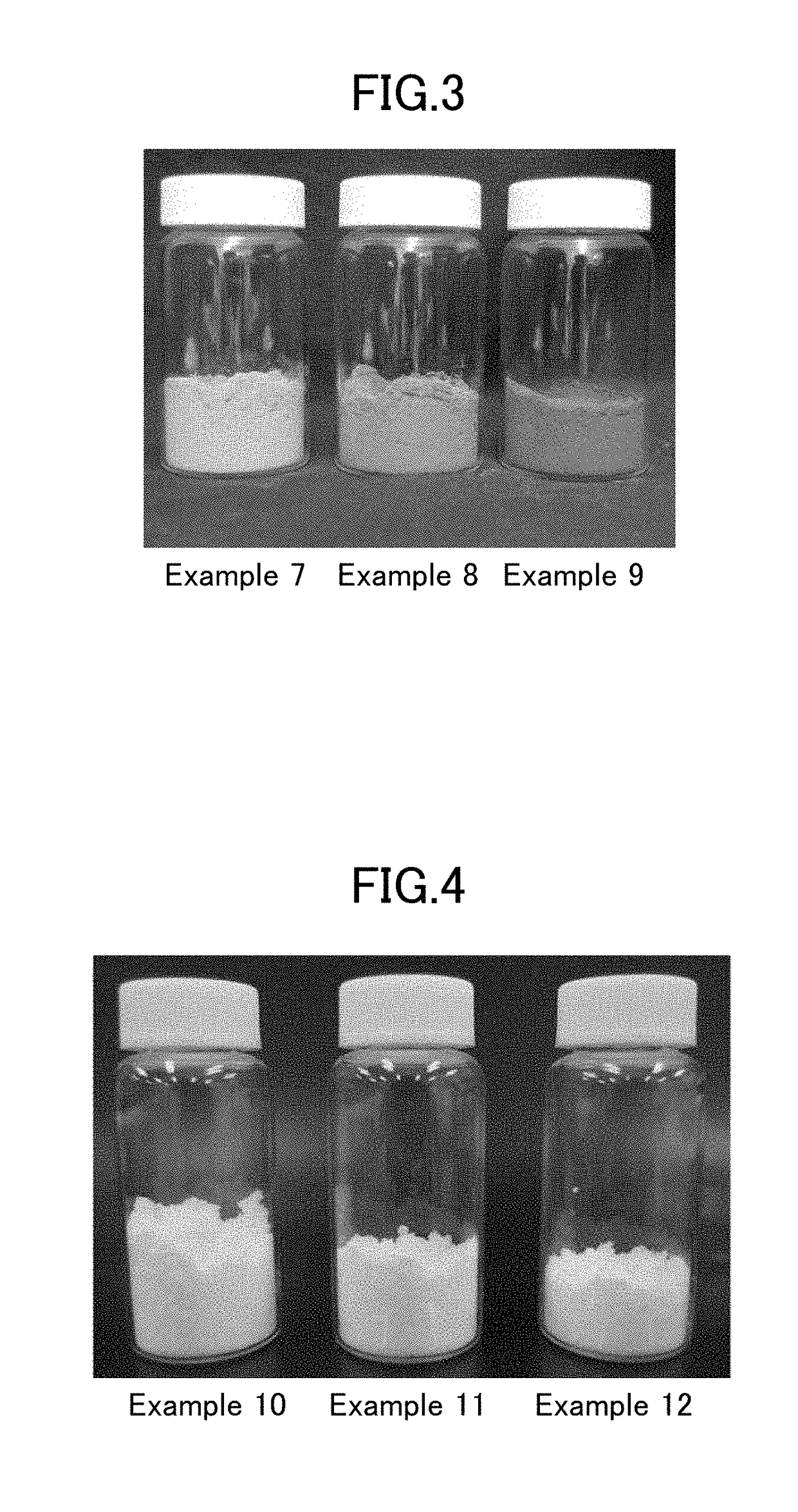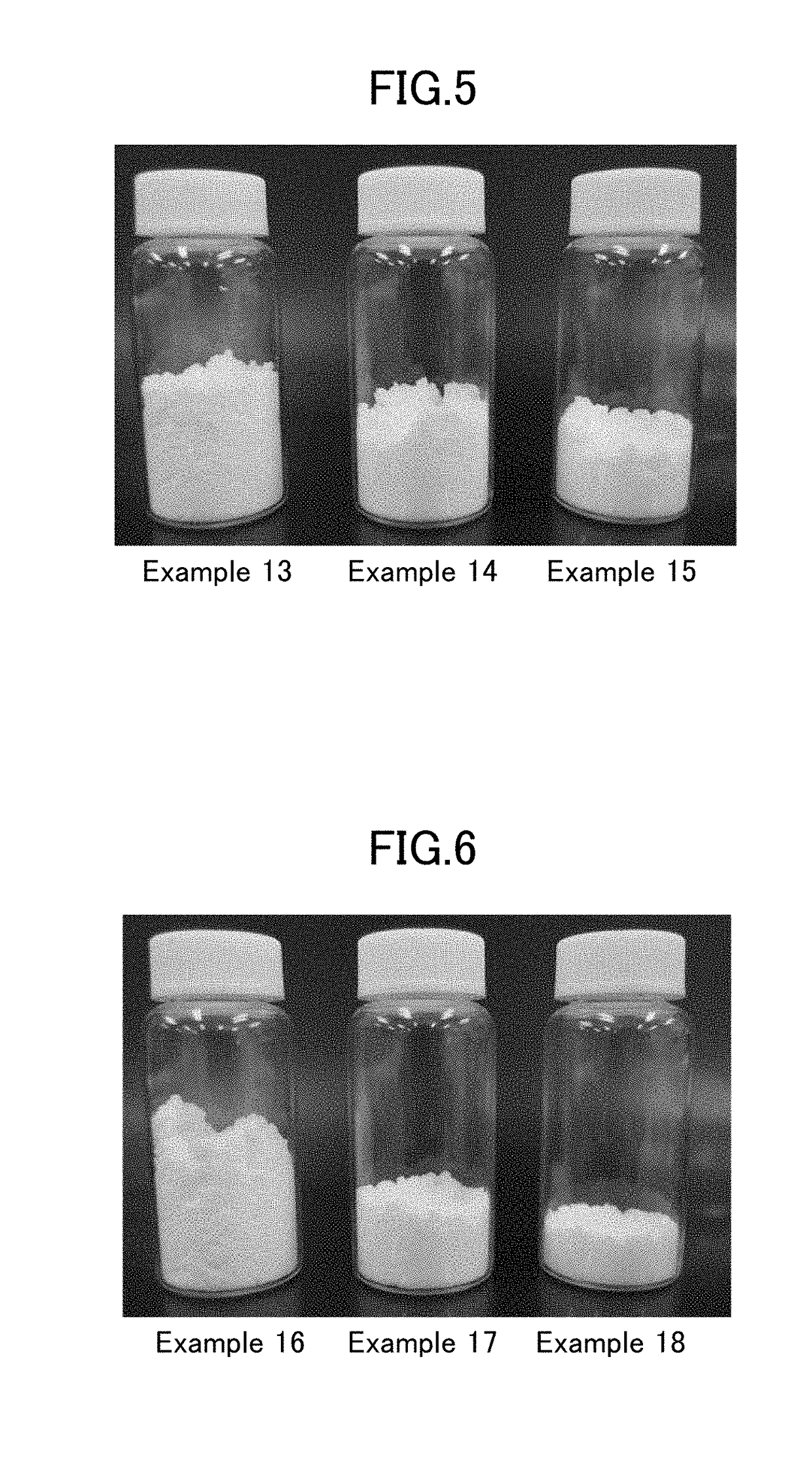Powderizing agent for liquid component
a technology of liquid components and powderizing agents, which is applied in the direction of fatty acid chemical modification, fatty-oil/fat/waxes solidification, toilet preparations, etc., can solve the problems of difficult blending methods and limited amount of liquid components, and achieve excellent handling effects
- Summary
- Abstract
- Description
- Claims
- Application Information
AI Technical Summary
Benefits of technology
Problems solved by technology
Method used
Image
Examples
example 1
[0266]Into a LABORAN screw tube jar No. 7 (manufactured by AS ONE Corporation), 9.9 g of the powderizing agent A and 0.1 g of (R)-(+)-Limonene (manufactured by Kanto Chemical Co., Inc.) were placed. These were kept at 60° C. for 0.5 hours and completely melt for mixing. Here, the amount of the liquid component used was 1% by mass relative to the total mass of the powder composition (powderizing agent A+liquid component). Next, the mixture was cooled in a 10° C.-thermostatic chamber for 0.5 hours (tempering process) and then was allowed to stand in a 20° C.-thermostatic chamber for 12 hours. Thus, a powder composition having voids with an increased volume was obtained.
[0267]The characteristics of the obtained powder composition were as follows.
[0268]loose bulk density: 0.3 g / cm3
[0269]average particle diameter: 121 μm
[0270]expansion ratio: ×3.9
[0271]As illustrated in FIG. 1, the powder composition obtained in Example 1 was in the form of powder.
example 2
[0272]Into a LABORAN screw tube jar No. 7 (manufactured by AS ONE Corporation), 9.7 g of the powderizing agent A and 0.3 g of (R)-(+)-Limonene (manufactured by Kanto Chemical Co., Inc.) were placed. These were kept at 60° C. for 0.5 hours and completely melt for mixing. Here, the amount of the liquid component used was 3% by mass relative to the total mass of the powder composition (powderizing agent A+liquid component). Next, the mixture was cooled in a 10° C.-thermostatic chamber for 0.5 hours (tempering process) and then was allowed to stand in a 20° C.-thermostatic chamber for 12 hours. Thus, a powder composition having voids with an increased volume was obtained.
[0273]The characteristics of the obtained powder composition were as follows.
[0274]loose bulk density: 0.3 g / cm3
[0275]average particle diameter: 147 μm
[0276]expansion ratio: ×2.5
[0277]As illustrated in FIG. 1, the powder composition obtained in Example 2 was in the form of powder.
example 3
[0278]Into a LABORAN screw tube jar No. 7 (manufactured by AS ONE Corporation), 9.5 g of the powderizing agent A and 0.5 g of (R)-(+)-Limonene (manufactured by Kanto Chemical Co., Inc.) were placed. These were kept at 60° C. for 0.5 hours and completely melt for mixing. Here, the amount of the liquid component used was 5% by mass relative to the total mass of the powder composition (powderizing agent A+liquid component). Next, the mixture was cooled in a 10° C.-thermostatic chamber for 0.5 hours (tempering process) and then was allowed to stand in a 20° C.-thermostatic chamber for 12 hours. Thus, a powder composition having voids with an increased volume was obtained.
[0279]The characteristics of the obtained powder composition were as follows.
[0280]loose bulk density: 0.4 g / cm3
[0281]average particle diameter: 198 μm
[0282]expansion ratio: ×1.6
[0283]As illustrated in FIG. 1, the powder composition obtained in Example 3 was in the form of powder.
[0284]Examples 4 to 6 employed vanillin...
PUM
| Property | Measurement | Unit |
|---|---|---|
| temperature | aaaaa | aaaaa |
| temperature | aaaaa | aaaaa |
| mass ratio | aaaaa | aaaaa |
Abstract
Description
Claims
Application Information
 Login to View More
Login to View More - R&D
- Intellectual Property
- Life Sciences
- Materials
- Tech Scout
- Unparalleled Data Quality
- Higher Quality Content
- 60% Fewer Hallucinations
Browse by: Latest US Patents, China's latest patents, Technical Efficacy Thesaurus, Application Domain, Technology Topic, Popular Technical Reports.
© 2025 PatSnap. All rights reserved.Legal|Privacy policy|Modern Slavery Act Transparency Statement|Sitemap|About US| Contact US: help@patsnap.com



